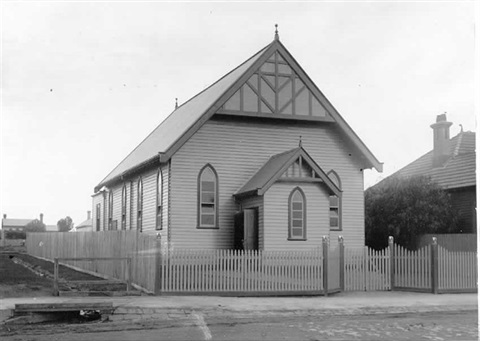Church of Christ, Preston

81 High Street, Preston
A church built in a day!
The Church of Christ held their first service in Preston in 1902.
The following year they bought land for a new building and started an ambitious plan to build the new church all on one day.
The Church of Christ in Preston was indeed successfully built in a single day on Saturday 25 March 1911 on a vacant piece of land near Bell Station. More than 1000 people came to watch the spectacle. About 150 people helped with the job including over 60 carpenters, 22 plumbers and 30 painters from other churches in Melbourne. The contractors, Mr A Graham and Mr J May, planned a campaign which meant the work would be completed in about 16 hours. Skilled tradesmen all working together and not an IKEA instruction sheet in sight!
The tradesman arrived at the site early and by 7am were all hard at work and as the day passed, huge crowds arrived on packed trains and trams to witness the work as entertainment.
‘The earnestness and enthusiasm was remarkable: not even the sitting on a splinter or the banging of a finger with a hammer deterred those who were novices.’
Men and boys, women and girls all had jobs to do – boards were painted laid out on the grass, the foundation plate was made and another group crafted the walls and gables flat on the ground. A group of around 30 men would then hoist the wall upright as it was hammered into place by others. The women collected wood shavings to light the fires for cooking meals for so many people.
By 4pm some reports say there were around 4000 sightseers, other reports saying many more. The Northcote Leader reported that ‘the interest was by no means confined to local people. The news of what was afoot seemed to spread as if by magic, and early in the afternoon streams of people by train, tram, motor car, buggy, bicycle and every other kind of conveyance commenced to pour into Preston. All told the visitors must have numbered tens of thousands.’
Plumbing work could not be done until towards the end of the day, when the scaffolding had been taken down. The local Fire Brigade provided light from their torches for the job to be completed.
By 10pm, gas and water had been connected, seating installed, the vestry and platform carpeted and the preacher’s desk put in.
At midnight the piles of timber and roofing iron had been transformed into a fully built church measuring 66feet 6inches long and 31feet wide.
One of the contractors, Mr Graham commented afterwards, ‘If only I could get a gang of men who would work the way those fellows did. I could make my fortune in a year. I’ve never seen men so eager and so keen.’
The first service was held the very next morning, led by Reverend Thomas Bagley who had worked on the building all through the day before. This was followed by another service in the afternoon and one in the evening – all packed full of people.
This impressive feat was performed in the days before Preston had electric power and you can see from the photograph that horses and carts were still very much the favoured form of transport.
Mr George Wardrop was very enterprising – you can see his advertising board for his Tailoring business in the midst of the crowds.
The trend for building a church in a day continued throughout Australia in the following years. A news article in 1912 describing a church being built in Port Pirie, South Australia, notes that, ‘Mr Thomas Bagley first started the “Church in a day” movement at Preston. Since then it has spread to New South Wales, West Australia and South Australia’.
Carroll, Brian & Rule, Ian (1985). Preston: an Illustrated History. Preston: City of Preston, p.114-115
Church built in a day. The Australasian (Melbourne, Vic. 1864-1946), 1 April 1911, p.31-32
Church built in a day. Preston enterprise: over sixty carpenters. Argus (Melbourne, Vic.1848 - 1957), Monday 27 March 1911, p. 6
Built in a day. The Herald (Melbourne, Vic. 1861-1954) 4 November 1912, p.4
A church in a day: the great feat at Preston. Northcote Leader
(Northcote, Vic.1882 -), 1 April 1911, p.2